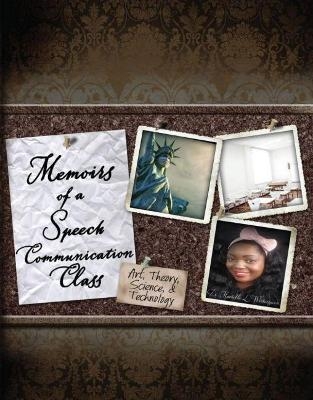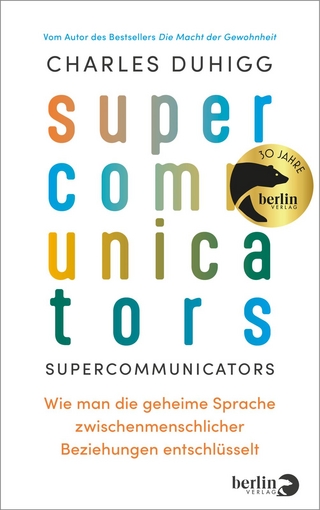
Memoirs of a Speech Communication Class
Kendall/Hunt Publishing Co ,U.S. (Verlag)
978-1-7924-3959-9 (ISBN)
- Titel nicht im Sortiment
- Artikel merken
Memoirs of a Speech Communication Class: Art, Theory, Science & Technology is a Speech Communications textbook that students can use as they matriculate through their college careers and life.
Acknowledgments & Contributions
Introduction: Rationale for the Inclusion of Student Memoirs
PART ONE: COMMUNICATION AS AN ART
CHAPTER 1 Public Speaking: Essentials for Excellence
Public Speaking: Essentials for Excellence
Public Speaking Is a Valuable Activity
Public Speaking Influences Success in College
Public Speaking Teaches Critical Thinking Skills
Public Speaking Skills Influence Career and Community Success
Public Speaking Skills Are Key to Leadership
Public Speaking Skills Complement Technology
Public Speaking Is Part of Our Democratic Tradition
Public Speaking and the Communication Process
Eight Elements of the Communication Process
Five Steps for Preparing to Speak
Conclusion
What You've Learned:
Student Memoir: Public Speaking Essentials for Excellence
CHAPTER 2 The Impact of Perception and Listening on Interpersonal Communication
Perception and Interpersonal Communication
Selectivity Processes
Organization
Interpretation
Individual Differences and Perceptions
The Link Between Perception and Listening
Listening Styles
Gender, Culture, and Personality Differences in Listening Styles
Best Practices for Effective Listening
Summary
Student Memoir: The Impact of Perception and Listening on Interpersonal Communication
CHAPTER 3 Blending Theory, Skill, and Art for Public Communication Competence
Aristotle's View of Public Communication Competence
Modern View of Public Communication Competence
Why We Communicate
Why We Communicate in the Public Communication Context
Five Major Skill Areas of Public Communication
Diversity Issues and Communication Competence
Critical Thinking Issues and Communication Competence
Applying the Chapter to Your Life
Student Memoir: Blending Theory, Skill, and Art for Public Communication Competence
CHAPTER 4 The Process of Selecting a Topic and Relevant Material to Engage the Audience
Select Meaningful Topics
Collect Relevant Material to Support Your Ideas
Statistics
Quotes
Examples
Additional Forms of Support
Student Memoir: The Process of Selecting a Topic and Relevant Material to Engage the Audience
CHAPTER 5 The Importance of Audience Analysis and Audience Adaptation to Delivery Dynamics
Part I Analyzing and Adapting to Diverse Audiences
Identifying Your Target Audience
Analyzing Your Audience
Building Your Skills
Adapting to Your Audience
Building Your Skills
Part II Audience Analysis and Delivery Dynamics
Student Memoir: The Importance of Audience Analysis and Audience Adaptation to Delivery Dynamics
CHAPTER 6 Research and Supporting Material
Develop a Research Strategy
Supporting Your Speech
Documenting Information Accurately in Your Speech
Student Memoir: Conducting Research for the Speech
CHAPTER 7 Organization and Outlining
Part I The Primary Goal of Organization is to Ensure you have an Effective Speech
Public Speaking is Purposeful
Steps In Organizing a Speech
Writing The Outline
Part II Canon of Arrangement
Introduction
What's Arrangement?
Maintain the 'You' Perspective
The Stock Patterns
The Outline, In Depth
Introductions and Conclusions
Summary
Part III Body of the Speech
Bodies
Signposts
Conclusions
Speech Outlines
Types of Outlines
Formatting Bibliographies
Student Memoir: The Canon of Arrangement (Organizing and Outlining the Speech)
CHAPTER 8 The Power of Verbal and Nonverbal Communication
Introduction
What Is Language?
What Are the Basic Principles of Language?
How Do Theorists Describe Language and Meaning?
How Can I Use Language Effectively?
What Should You Take from This Section on Language?
What Is Nonverbal Communication?
What Is the Nature of Nonverbal Communication?
What Are the Characteristics of Nonverbal Communication?
What Are the Functions of Nonverbal Communication?
What Are the Types of Nonverbal Communication?
How Does Theory Describe Nonverbal Behavior's Impact on Relationships?
What Are the Key Points to Remember about Nonverbal Communication?
Student Memoir: The Power of Verbal and Nonverbal Communication
CHAPTER 9 The Key to Informative Speaking
Differentiating Informative, Persuasive, and Entertaining Purposes
Types of Informative Speaking
Five Goals of Informative Speaking
Guidelines for Effective Informative Speeches
Ethics of Informative Speaking
Student Memoir: The Key to Informative Speaking
CHAPTER 10 Persuasive Speech Organization and Methods of Persuasion
Core Structure
Organization and the Proposition
Dealing with Counterarguments
Looking over the Outline
Introductions and Conclusions
Student Memoir: Persuasive Speech Organization and Methods of Persuasion
CHAPTER 11 Speaking for Special Occasions
Speaking for Special Occasions
Special-Occasion Speeches
Speeches of Introduction
Speeches of Presentation
Speeches of Acceptance
Commemorative Speeches
Keynote Speeches
After-Dinner Speeches
Outlines for Other Special-Occasion Speeches
Speaking for Special Occasions
Student Memoir: Speaking for Special Occasions
PART TWO: COMMUNICATION THEORY AND SCIENCE
CHAPTER 12 Communication Theory, Research, and Scholarship
Part I Why We Study Communication
Importance of Studying Communication
Communication Is Complex
Communication Is Vital to Workplace Effectiveness
A Higher Education Does Not Ensure Communication Competence
Theories: Guides for Analysis and Action
Defining Communication
Fundamentals of Communication
Communication: Our Definition
Part II Perspectives on Communication
The Scientific Method
What Makes a Quality Communication Theory?
Communication Theory Development
Fundamental Goals of Communication Theory
Seven Theoretical Traditions in Building Communication Theory
Part III What is Communication Research?
What Will You Do with the Information You Learn in this Course?
What Is Research?
How Is Research Knowledge Distributed?
How Do We Know What We Know?
What's Wrong with Everyday Ways of Knowing?
Scientific Reasoning
What Do Communication Researchers Do?
What Are Some Examples of Communication Research?
Student Memoir: Communication Theory, Research, and Scholarship
CHAPTER 13 Relationship Development and Maintenance from Face-to-Face Cyberspace
Part I Relationship Development
Overview
Deciding to Make The First Move: Why We Initiate Relationships
Interpersonal Attraction
Proximity
Similarity/Homophily
Interpersonal Goals
Interpersonal Communication Theories: How we Initiate Relationships
Significance of Relationship Maintenance
Why We Maintain Some Relationships and not Others
Relationship Maintenance Strategies
Relationship Maintenance in Different Types of Relationships
Assessing Relationship Problems: Attributions, Satisfaction, Equity
How do You Determine if a Relationship Problem is Significant?
Five Stages of Relationship Dissolution
Strategies used to Terminate Relationships
Types of Relationships: Terminating Friendships
Types of Relationships: Terminating Romantic Relationships
Homosexual Relationships: Factors Influencing Relationship Quality
After The Breakup: Remaining "Just Friends"
Part II From Face-to-Face to Cyberspace Forming Relationships Online
Overview
Methods Of Developing Interpersonal Relationships
Establishing Relationships: Before The Internet
Establishing Relationships: The Internet Era
What Attracts People To One Another Online?
Who Is Online And Why?
Effects Of Cmc Relationships
Forming Safe And Meaningful Online Relationships
Student Memoir: Relationship Development and Maintenance from Face-to-Face to Cyberspace
CHAPTER 14 From Voice Articulation and Production to Common Social Communication Disorders
Part I Voice Articulation and Production
Overview of Speech Mechanism and Vocal Anatomy
Front Vowels
Back Vowels
Middle Vowels
"Voice Recorder Software"
Part II Common Social Communication Disorders
Development of Social Skills
Comprehensive Assessment
Treatment of Social Communication Deficits
Student Memoir: from Voice Articulation and Production to Common Social Communication Disorders
PART THREE: COMMUNICATION IN A TECHNOLOGICALLY-SAVVY SOCIETY
CHAPTER 15 Leadership and Small Group Communication
Introduction
Defining and Understanding Small Groups
Advantages and Disadvantages of Group Work
Team Building
Running and participating in a Successful Meeting
ICT and Small Groups
Student Memoir: Leadership and Small Group Communication
CHAPTER 16 Face-to-Face and Virtual Interviews
What Is Interviewing?
What Types of Questions Are Used in Interviews?
How Do I Prepare For A Face-To-Face & Virtual Interview?
How Are Interviews Structured?
Student Memoir: Face-to-Face and Virtual Interviews
CHAPTER 17 Mediated and "Masspersonal" Communication Technologies for Online Speaking
Part I What is Mediated Communication?
What Is Communication?
Components of Communication
The Shannon-Weaver Model of Communication
Mass Mediated Communication
Interpersonal Communication
Changes in Technology Highlight Changes in Lines of Delineation
Changes in Mediated Communication
Moving Toward MC
Part II Online Speaking
Advantages
Face-to-Face Speaking versus Online Speaking
Technology for Online Speaking
Formats of Online Speaking
Camera Presence
Student Memoir: Mediated and "Masspersonal" Communication Technologies for Online Speaking
| Erscheinungsdatum | 01.10.2021 |
|---|---|
| Verlagsort | Iowa |
| Sprache | englisch |
| Gewicht | 1530 g |
| Themenwelt | Sachbuch/Ratgeber ► Beruf / Finanzen / Recht / Wirtschaft ► Briefe / Präsentation / Rhetorik |
| Sozialwissenschaften ► Kommunikation / Medien ► Kommunikationswissenschaft | |
| ISBN-10 | 1-7924-3959-8 / 1792439598 |
| ISBN-13 | 978-1-7924-3959-9 / 9781792439599 |
| Zustand | Neuware |
| Haben Sie eine Frage zum Produkt? |
aus dem Bereich


